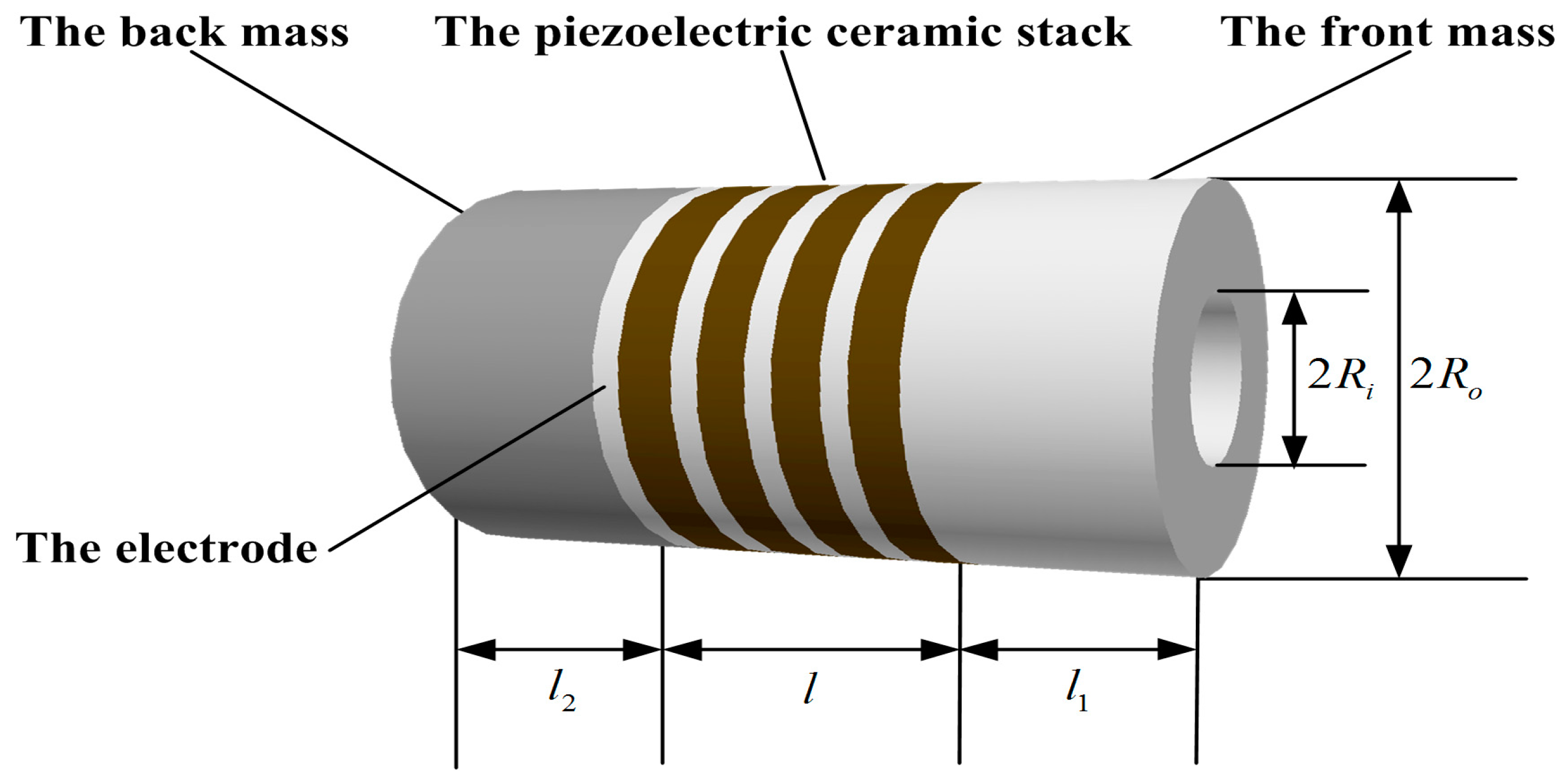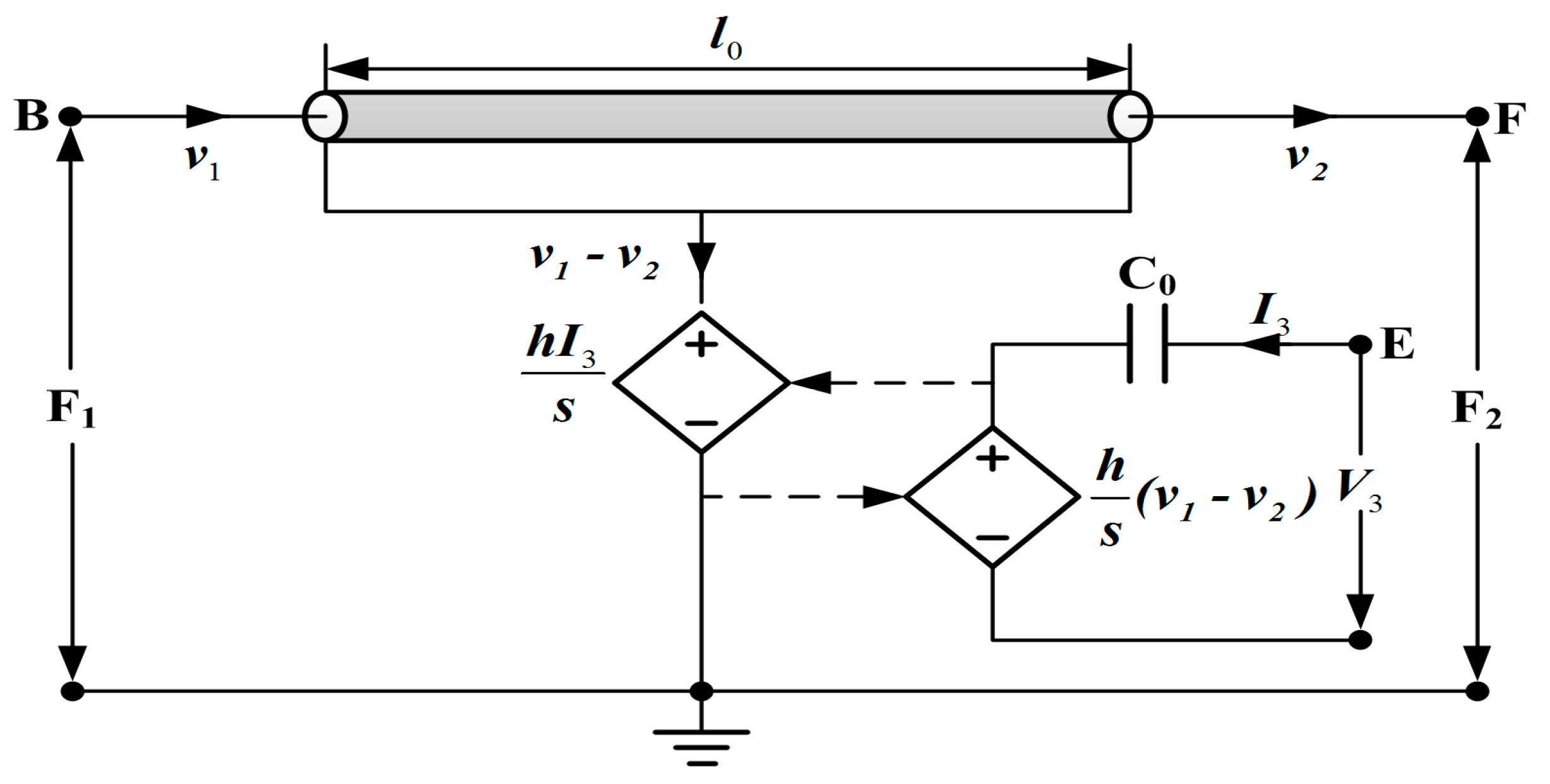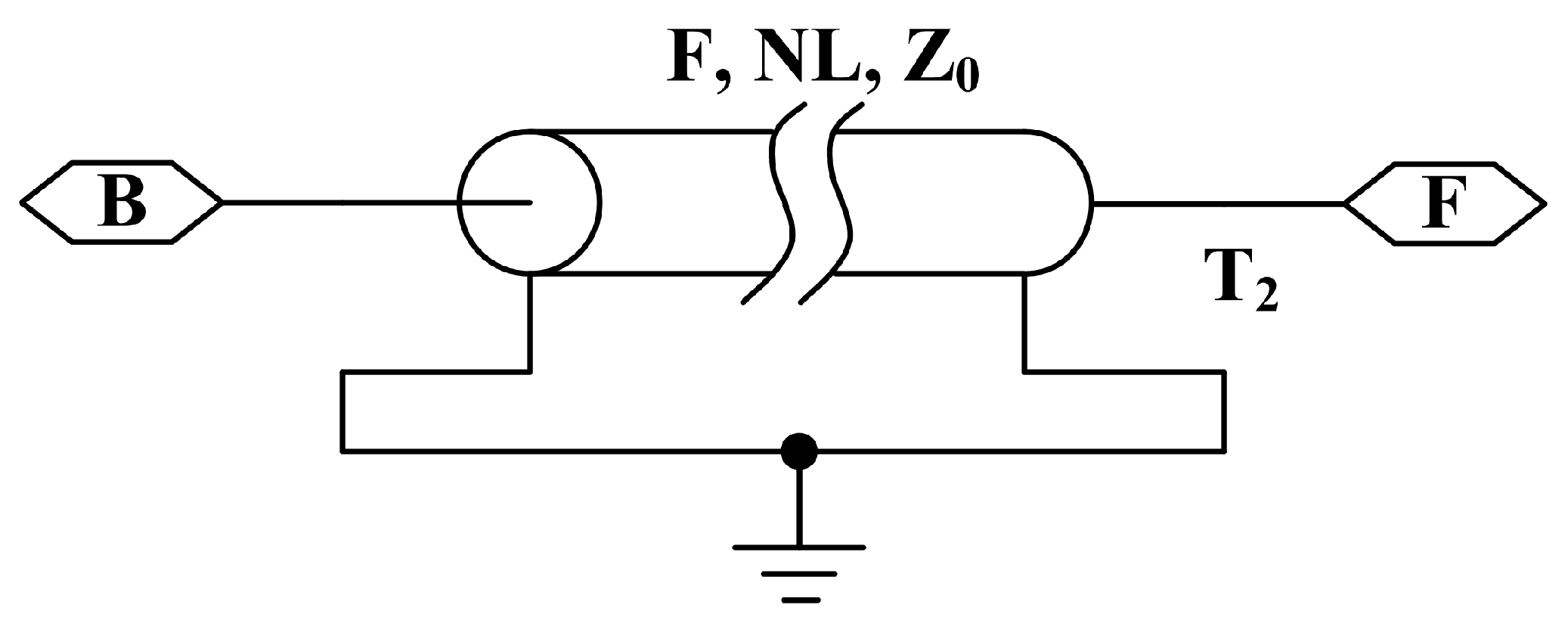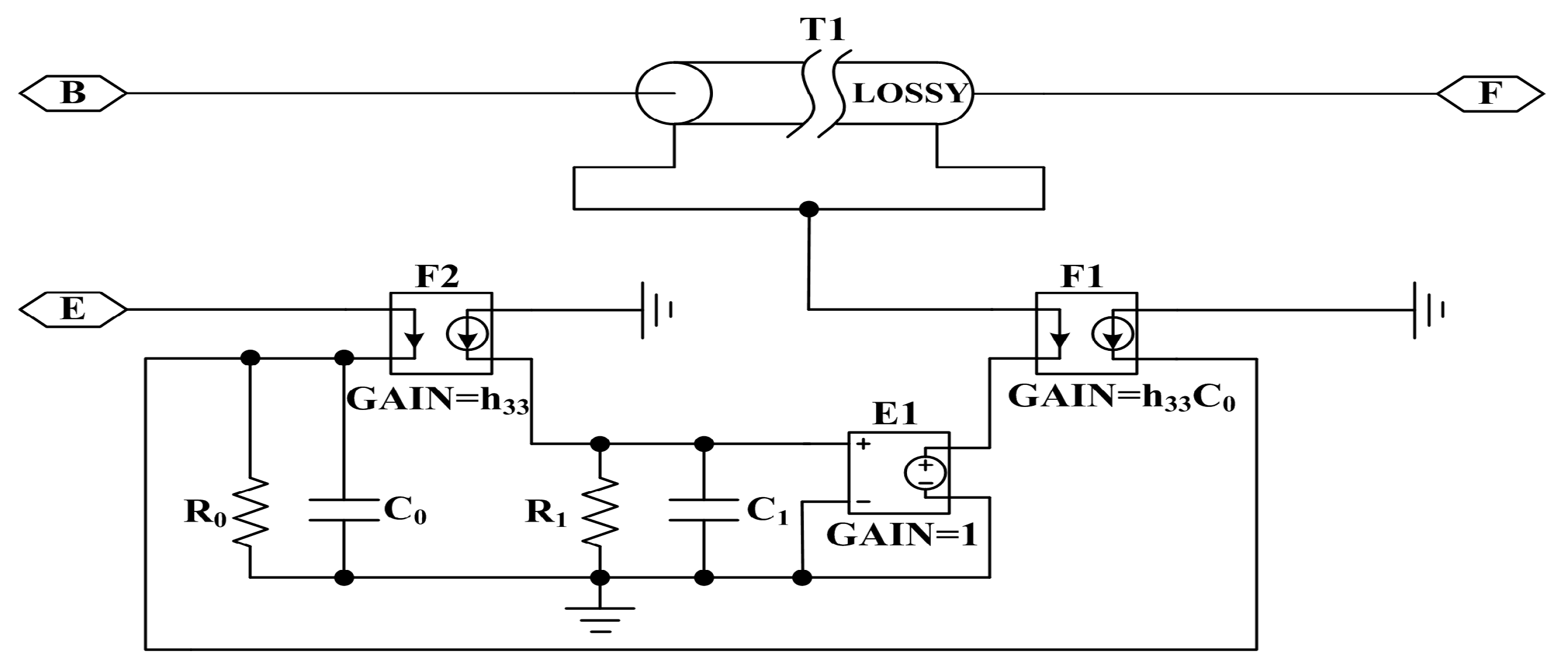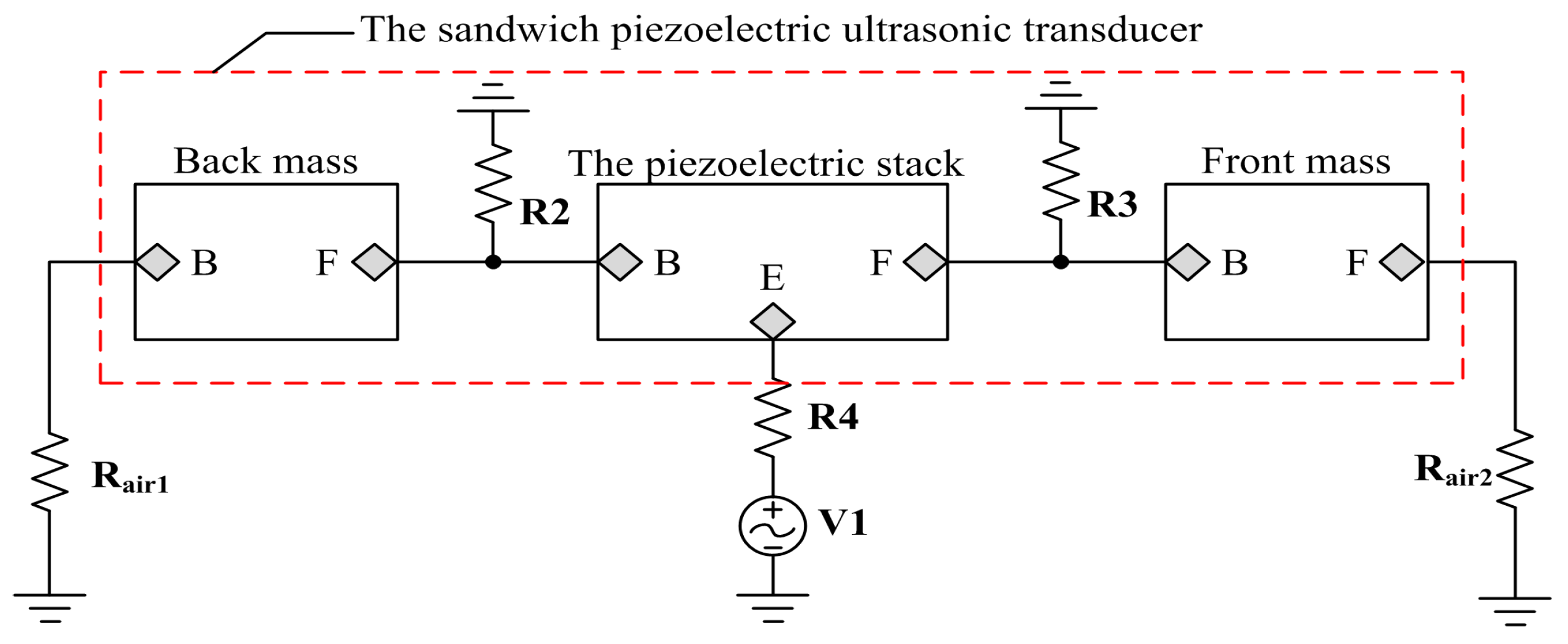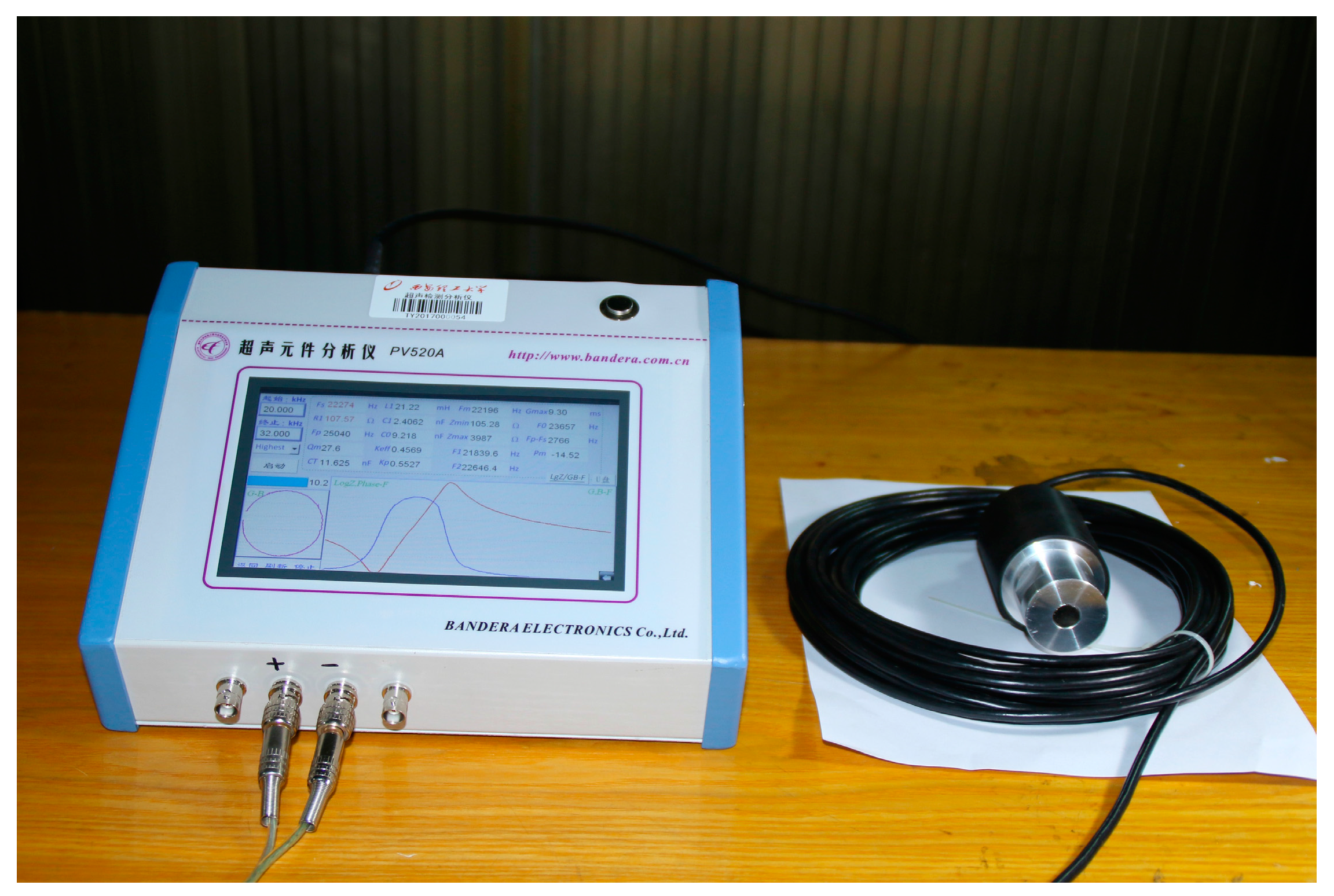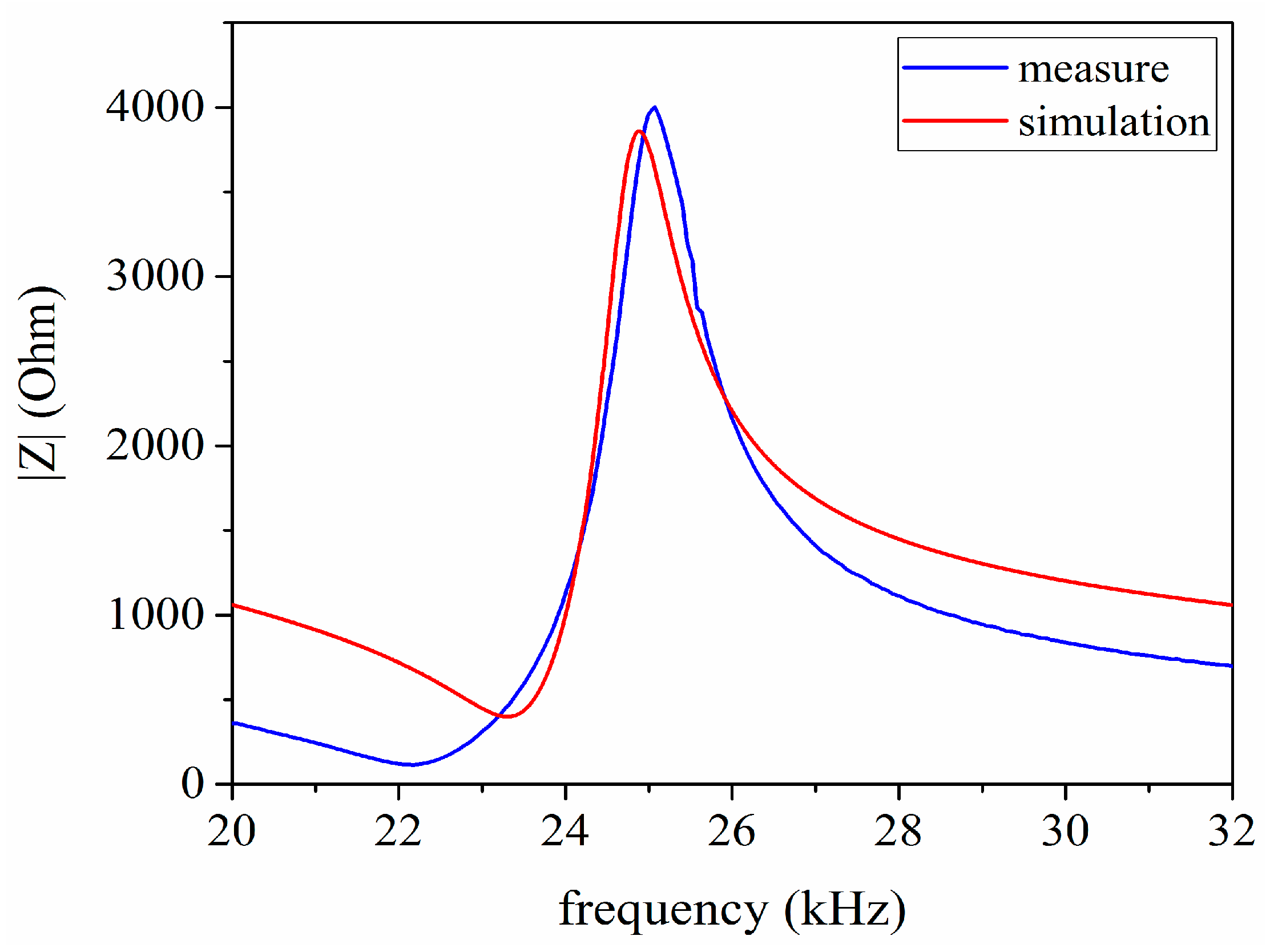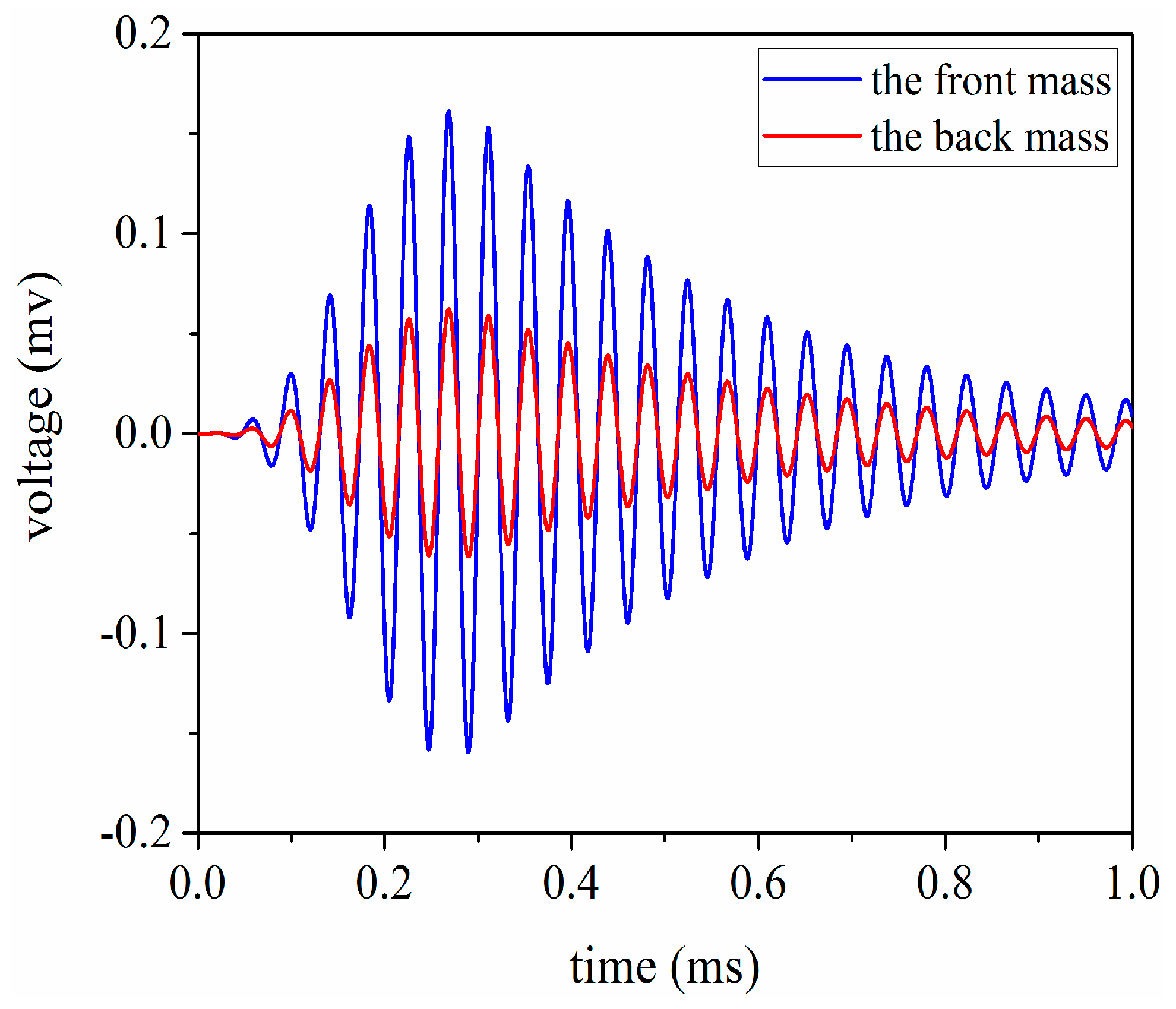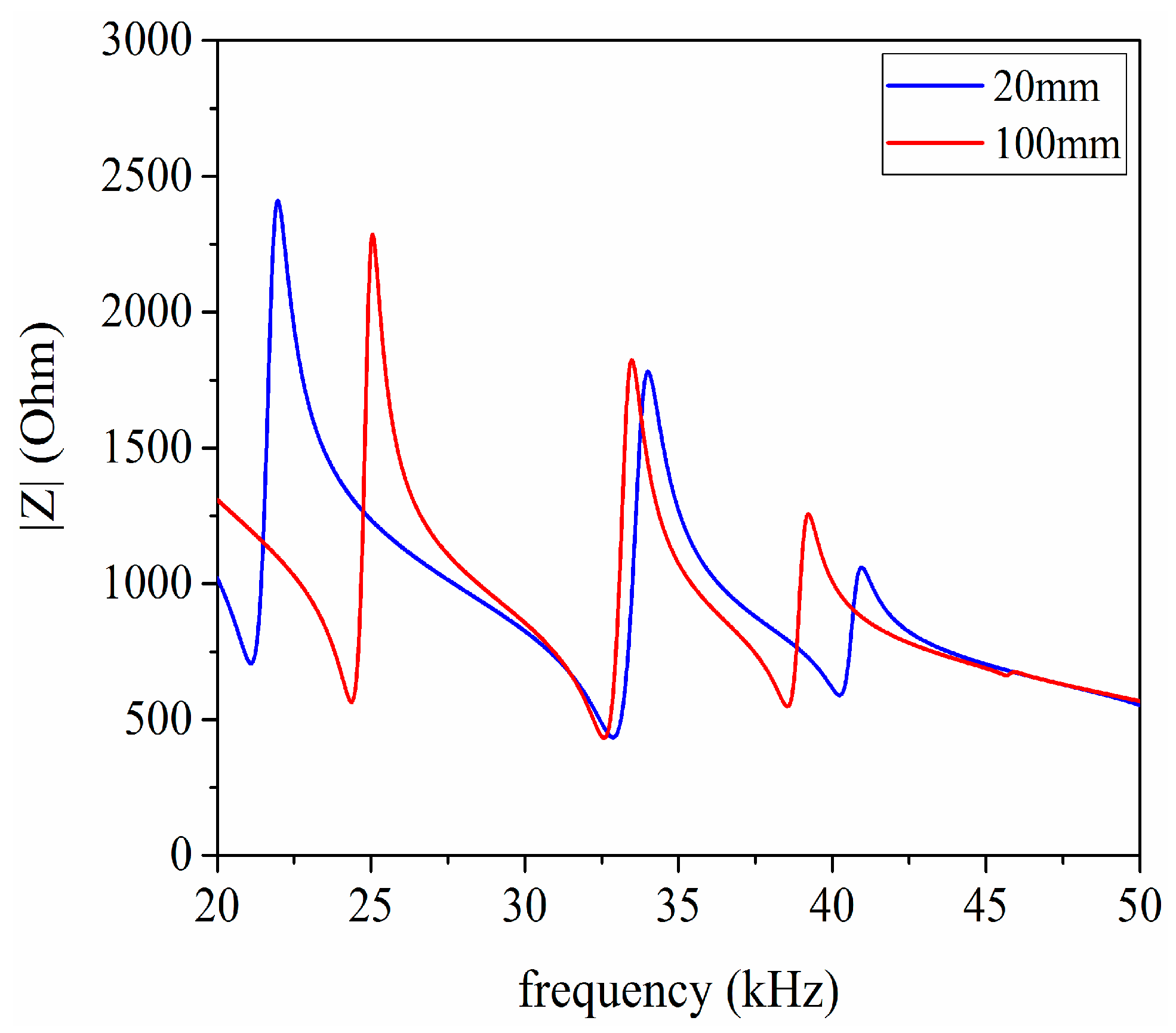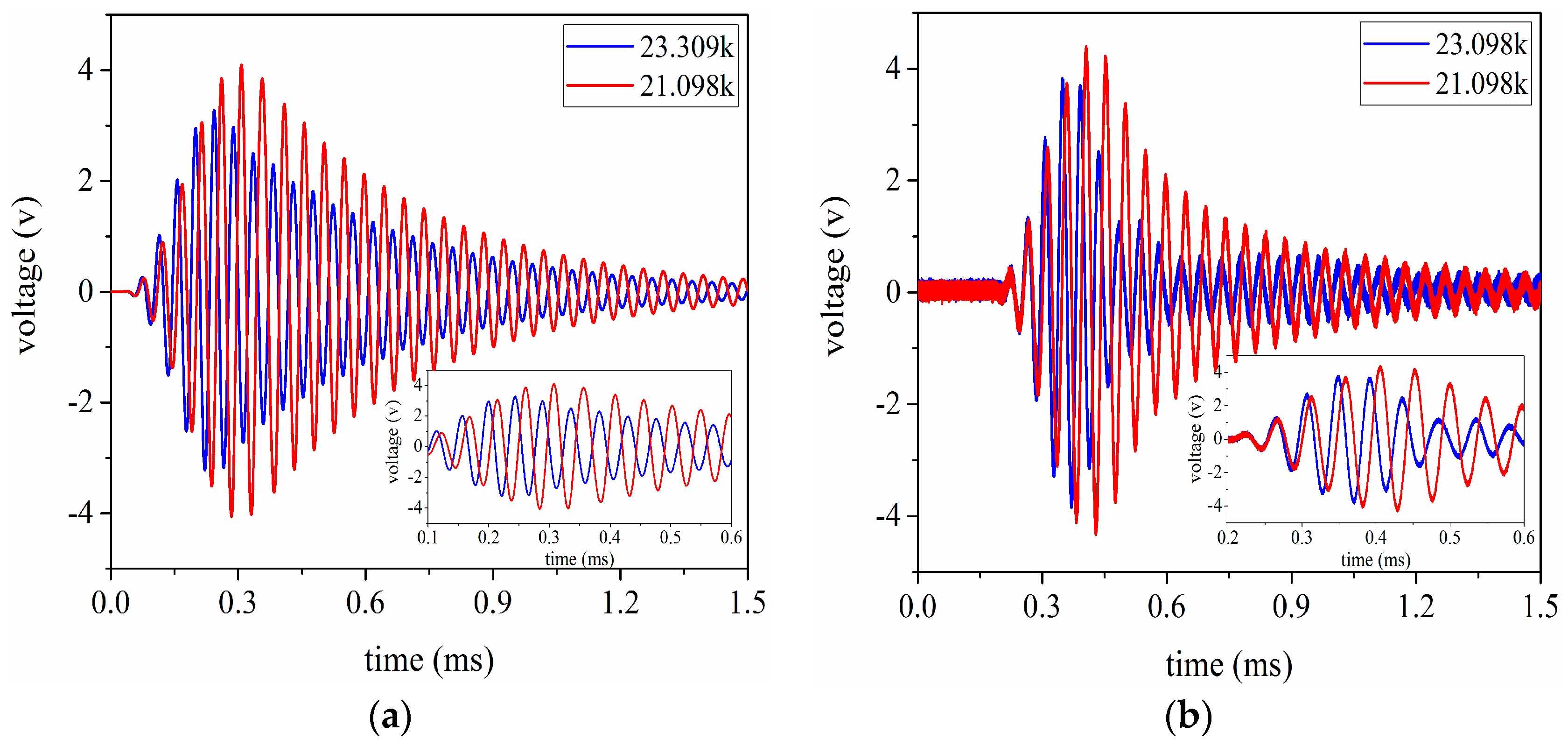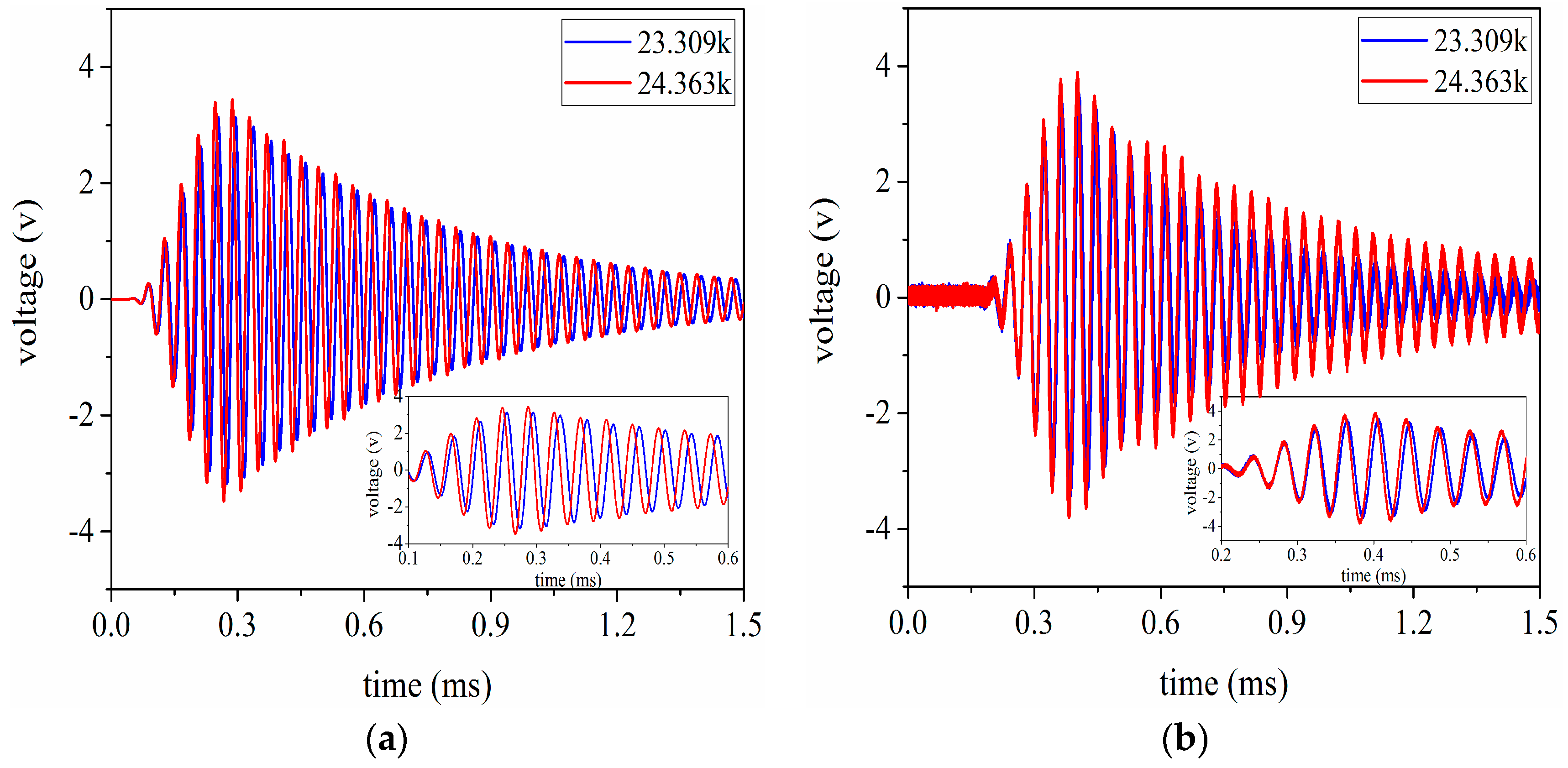For establishing the PSpice model of the sandwich piezoelectric ultrasonic transducer vibrating in longitudinal direction, the one-dimensional wave and transmission line theories for the piezoelectric vibrational mechanism in thickness mode are illustrated in this section.
2.1. Transmission Line and Wave Theories
To obtain the proper parameters used in simulations, the comparison of wave propagation is carried out in electrical transmission lines and acoustical medium, respectively. Consider a different length
of a transmission line from
Figure 2, which is illustrated by the parameters as follows [
16]:
represents the resistance per unit length in ,
represents the inductance per unit length in ,
represents the conductance per unit length in ,
represents the capacitance per unit length in .
Note that and are connected in series, and are connected in parallel.
To obtain the above parameters, Kirchhoff’s voltage law is used in the circuit from
Figure 2, we have
which leads to
With the limit as
, Equation (2) becomes
Similarly, by using Krichhoff’s current law to the node
in
Figure 2, we can derive
Then letting
, we can obtain
We call Equations (3) and (5) the general transmission-line equations, which are first-order partial differential equations based on
and
. For simplifying the pair partial differential equations, the time harmonic cosine function is used and the voltage
and the current
can be expressed as
where
is the angular frequency.
The general transmission line equations on the basis of
and
can be obtained
Equations (8) and (9) are called as time-harmonic transmission line equations which simplify to the following Equations (10) and (11) under the lossless conditions (
,
).
In order to obtain the propagation constant and characteristic impedance of transmission line, the time-harmonic transmission line equations are used. By means of differentiating them with respect to
, we can obtain [
16]
where
is called as the propagation constant. It is composed of an attenuation constant
in
and a phase constant
in
. It can be expressed as
The general solution of the differential Equation (12) is denoted as
and Equation (13) has the same form solution.
The time dependence for Equation (15) can be got by means of multiplying
, we can obtain
Equation (16) illustrates two traveling waves. One travels in the positive
direction with an amplitude
and it decays at a rate
, while the other travels in the opposite direction with an amplitude
and has the same decay-rate. The propagation of an acoustical wave is controlled by a pair of differential equations which have the same type as Equations (12) and (13). In the situation of harmonic waves, corresponding with Equations (12) and (13), the linearized acoustic plane wave with lossy Equations can be obtained [
17]:
here,
is called the pressure in
and
represents the particle velocity in
. Corresponding to
,
denotes also the complex wave number consisted of an attenuation constant
in
and a wave number
in
. The complex wave-number
can be expressed as
here,
is the relaxation time and
is the sound speed,
represents Young’s modulus and
is material density.
The general solution for Equation (17) is expressed as
and is corresponding with the electrical transmission line’s solution Equation (16). In addition, Equation (18) has a solution of the same form. Combined with Equations (19) and (20), we can derive
The characteristic impedance
of the lossy transmission line is given as [
16]
The characteristic acoustic impedance
of the lossy acoustical medium is represented as
here,
denotes the medium’s density in
. Equations (23) and (14) are expanded in order to approximate the characteristic impedance and propagation constant by reserving the low order parts. They are rewritten as
Now we take small but non-negligible losses into consideration and suppose
,
and
. Based on these assumptions, the second term of Equation (25) is neglected, only keeping the
as the characteristic impedance. Likewise, according to Equation (24), the low acoustical characteristic impedance is derived as
. In addition, the wave-number
to Equation (22) can be approximately expressed as
. By using the approximate assumptions mentioned above again, according to Equation (26) the phase constant
can be obtained as
. For the purpose of correlating the two theories, the impedance type analogy relationship is selected in which the mechanical force is denoted by the voltage and the current denotes particle velocity. The equivalence between the systems is denoted as
here,
is the cross-sectional area for the acoustic beam in
.
The relationship of the low-loss characteristic impedance Equation (27) is used to obtain the following expressions
The real part of Equation (26) is called as the attenuation constant
as follows:
Corresponding to Equation (30), the classical theory relationship of acoustic attenuation is obtained as
here,
denotes the attenuation coefficient resulting from viscous losses while
is the attenuation coefficient deriving from the thermal conduction.
According to Equations (28)–(30), we can derive the following expressions
Because of the materials used in the sandwich piezoelectric ultrasonic transducer having a low heat conductance, the loss resulting from the thermal conductance can be neglected. Then letting the conductance
, we can get
here,
is mechanical loss factor and
is mechanical quality factor.
Therefore, Equation (32) can be rewritten as
Finally, the parameters of the acoustical lossy transmission line can be derived as follows:
2.2. Piezoelectric Ceramic Ring Vibrating in Thickness Mode
The thickness direction vibration of the thickness poled piezoelectric ceramic rings is a general vibration mode. For this kind of thickness poled piezoelectric ceramic ring, its thickness is much lower than diameter. It is assumed that it works in the thickness mode. For the piezoelectric ring with fixed or free ends vibrating in thickness mode, it has a fundamental resonant frequency [
18]:
here,
denotes acoustic velocity in piezoelectric material and
denotes the thickness of a piezoelectric ceramic ring.
,
are the external forces applied to the back and front surfaces of the piezoelectric ceramic ring,
is its thickness,
indicates its cross-section area,
and
represent the particle speed,
,
denotes the voltage and current respectively and the
axis indicates the vibrating direction as shown in
Figure 3.
For modeling a sandwiched piezoelectric ceramic transducer vibrating in longitudinal mode, the piezoelectric ring is modeled using Leach’s equivalent circuit model [
9] as shown in
Figure 4.
It consists of the clamped capacitance
, a transmission line used to represent the mechanical parts of the piezoelectric ring, and two controlled sources used for indicating the coupling between the electrical and mechanical sections of the piezoelectric ring. Here,
is the piezoelectric constant,
is the Laplace operator, the nodes B, E and F represent the back face, the front face and the electrical terminal of the piezoelectric ceramic ring, respectively. For the electrical part, the clamped capacitance
is given as follows
here,
is the clamped dielectric impermeability, the cross-section area
.
